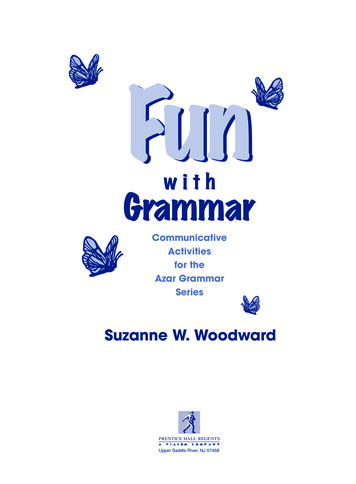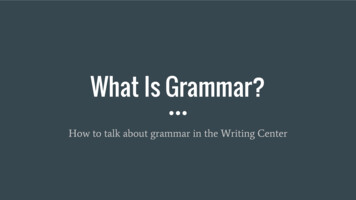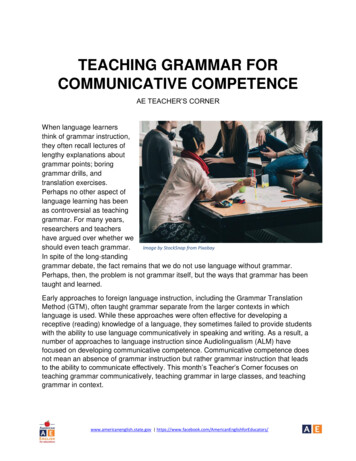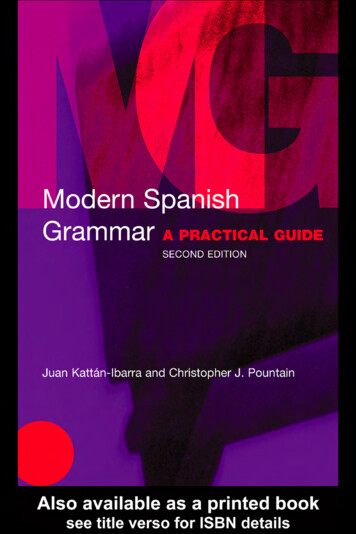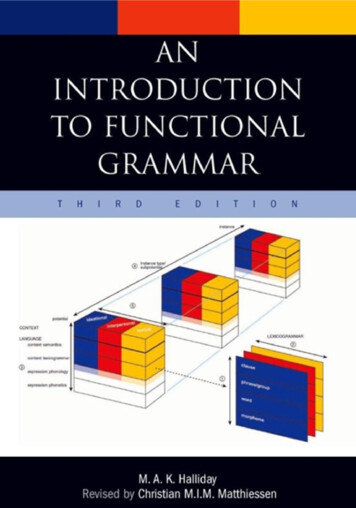
Transcription
AnIntroductionto FunctionalGrammarT H I R DE D I T I O N
This page intentionally left blank
AnIntroductionto FunctionalGrammarT H I R DE D I T I O NM.A.K. HallidayEmeritus Professor of LinguisticsUniversity of Sydney, AustraliaRevised by Christian M.I.M. MatthiessenProfessor of LinguisticsMacquarie University, AustraliaHodder ArnoldA MEMBER OF THE HODDER HEADLINE GROUP
First published in Great Britain in 2004 byArnold, a member of the Hodder Headline Group,338 Euston Road, London NW1 3BHhttp://www.hoddereducation.comDistributed in the United States of America byOxford University Press Inc.198 Madison Avenue, New York, NY10016 2004 M.A.K. Halliday and Christian MatthiessenAll rights reserved. No part of this publication may be reproduced ortransmitted in any form or by any means, electronically or mechanically,including photocopying, recording or any information storage or retrievalsystem, without either prior permission in writing from the publisher or alicence permitting restricted copying. In the United Kingdom such licencesare issued by the Copyright Licensing Agency: Saffron House, 6–10 Kirby Street,London EC1N 8TS.The advice and information in this book are believed to be true andaccurate at the date of going to press, but neither the authors nor the publishercan accept any legal responsibility or liability for any errors or omissions.British Library Cataloguing in Publication DataA catalogue record for this book is available from the British LibraryLibrary of Congress Cataloging-in-Publication DataA catalog record for this book is available from the Library of CongressISBN-10: 0 340 76167 9ISBN-13: 978 0 340 76167 03 4 5 6 7 8 9 10Typeset in 10 on 12.5pt Berling by Phoenix Photosetting, Chatham, KentPrinted and bound in IndiaWhat do you think about this book? Or any other Hodder Arnold title?Please send your comments to www.hoddereducation.com
ContentsPrefacePart IixThe Clause1 The1.11.21.31.41architecture of language 3Text and grammar 3Phonology and grammar 11Basic concepts for the study of language 19The location of grammar in language; the role of the corpus2 Towards a functional grammar 372.1 Towards a grammatical analysis 372.2 The lexico-grammar cline 432.3 Grammaticalization 462.4 Grammar and the corpus 482.5 Classes and functions 502.6 Subject, Actor, Theme 532.7 Three lines of meaning in the clause31583 Clause as message 643.1 Theme and Rheme 643.2 Group or phrase complexes as Theme; thematic equatives3.3 Theme and mood 713.4 Textual, interpersonal and topical Themes 793.5 The information unit; Given New 873.6 Given New and Theme Rheme 933.7 Predicated Themes 953.8 Theme in bound, minor and elliptical clauses 983.9 Thematic interpretation of a text 10068
CONTENTS4 Clause as exchange 1064.1 The nature of dialogue 1064.2 The Mood element 1114.3 Other elements of Mood structure 1214.4 MOOD as system; further options 1344.5 Polarity and modality 1434.6 Absence of elements of the modal structure4.7 Clause as Subject 1544.8 Texts 1581515 Clause as representation 1685.1 Modelling experience of change 1685.2 Material clauses: processes of doing-and-happening 1795.3 Mental clauses: processes of sensing 1975.4 Relational clauses: processes of being and having 2105.5 Other process types: summary of process types 2485.6 Circumstantial elements 2595.7 Transitivity and voice: another interpretation 2805.8 Text illustrations 303Part IIAbove, Below and Beyond the Clause3076 Below the clause: groups and phrases 3096.1 Groups and phrases 3096.2 Nominal group 3116.3 Verbal group 3356.4 Adverbial group, conjunction group, preposition group6.5 Prepositional phrase 3596.6 Word classes and group functions 3613547 Above the clause: the clause complex 3637.1 The notion of ‘clause complex’ 3637.2 Types of relationship between clauses 3737.3 TAXIS: parataxis and hypotaxis 3837.4 Elaborating, extending, enhancing: three kinds of expansion7.5 Reports, ideas and facts: three kinds of projection 4417.6 Clause complex and tone 4827.7 Texts 4848 Group and phrase complexes 4868.1 Overview of complexing at group or phrase rank 4868.2 Parataxis: groups and phrases 4898.3 Hypotaxis: nominal group 4938.4 Hypotaxis: adverbial group or prepositional phrase 4958.5 Hypotaxis: verbal group, expansion (1): general 497vi395
Contents8.68.78.88.9Hypotaxis: verbal group, expansion (2): passives 505Hypotaxis: verbal group, expansion (3): causative 509Hypotaxis: verbal group, projection 515Logical organization: complexes at clause and group or phrase rank, andgroups 5219 Around the clause: cohesion and discourse 5249.1 The concept of text; logogenetic patterns 5249.2 The lexicogrammatical resources of COHESION9.3 Conjunction 5389.4 Reference 5499.5 Ellipsis and substitution 5619.6 Lexical cohesion 5709.7 The creation of texture 57953210 Beyond the clause: metaphorical modes of expression 58610.1 Lexicogrammar and semantics 58610.2 Semantic domains 59310.3 Modality 61310.4 Interpersonal metaphor: metaphors of mood 62610.5 Ideational metaphors 636ReferencesIndex659667vii
This page intentionally left blank
prefaceEarly in the new millennium, after the second edition of IFG had been on salefor some five or six years, I was asked by the publishers: would I like toconsider making some further revisions and preparing a third edition? I feltrather daunted by this prospect. I had worked very readily on IFG2, becausethere were features of the original which clearly needed revising, and I hadsome of the material already in hand. But this time, while there was no doubtthat the book could be further updated and improved, I was not sure that Ihad the necessary energy or expertise to undertake an IFG3.The obvious solution was to work in collaboration; and the obvious personto collaborate with was Christian Matthiessen, if he was willing and if he couldfind the time. He was; and he did.In the event, while I contributed a few sections to the revision, the lion’sshare of the work was taken on by Christian. The result is some way betweena revision and a new book. More prominence has been given to the systemnetworks which underpin the grammar; and there are many more textexamples, because the systemic functional model has been widely used in theanalysis of discourse. Inevitably, therefore, the book has become rather longerthan it was before. I hope this has not made it excessively recalcitrant tohandle! It is still (as I said of the first edition) a short introduction, given therichness and complexity of what it is introducing — the grammar of a humanlanguage.M.A.K. HallidayThe first chapter has been largely rewritten, beginning with the motif of usinga grammar to analyse text, and then introducing the fundamental theoreticalconcepts that make up the ‘architecture’ of a language: axis, stratification,instantiation, metafunction, composition. The notion of constituency(syntagmatic composition), previously used as the way into the grammar, is
PREFACEhere given less prominence. Chapters 3 and 4 have been tidied up and extended; andChapter 5 has been considerably rewritten, in order to make the very complex aspects oftransitivity more accessible and to provide more support for text analysis. Chapter 7 hasbeen extensively revised, with more material on the relationship between the clausecomplex and the rhetorical-relational organization of text; and what was ‘Chapter 7additional’ has become Chapter 8, because Chapter 8 in its original form has disappeared,the content being incorporated into the chapters to which it is related (Chapters 1, 3, 4 and7). Chapter 9 is still concerned with cohesion, but it has been expanded to include adiscussion of instantial patterns in general in text and the presentation of the subsystems ofcohesion has been reorganized so that it now starts with conjunction in order to foregroundthe link to clause complexing in the grammar and rhetorical-relational organization in thediscourse semantics.Throughout the chapters we have tried, within the space available, to provide a sense ofhow the grammar makes meaning in written and spoken text, illustrating the distinctivecontributions made by the different options within a given system. This is one step in thedirection of fleshing out the relationship between grammar and discourse semantics; buttexts inevitably take up a good deal of space, and we have had to remove a number ofexamples we had originally included. These will find their way into other publications, orbe added to a new website that we are designing as a companion to IFG.This web companion to IFG will enable us to make available certain material from IFG2that we were not able to include in this new edition. But it will also offer new material,including more text examples (spoken as well as written) and more discussion of particularpoints.M.A.K. Halliday & Christian M.I.M. Matthiessenx
part Ithe clause
This page intentionally left blank
chapteroneTHE ARCHITECTURE OF LANGUAGE1.1 Text and grammarWhen people speak or write, they produce text. The term ‘text’ refers to anyinstance of language, in any medium, that makes sense to someone whoknows the language (cf. Halliday and Hasan, 1976: Chapter 1). To agrammarian, text is a rich, many-faceted phenomenon that ‘means’ in manydifferent ways. It can be explored from many different points of view. Butwe can distinguish two main angles of vision: one, focus on the text as anobject in its own right; two, focus on the text as an instrument for findingout about something else. Focusing on text as an object, a grammarian willbe asking questions such as: Why does the text mean what it does (to me, orto anyone else)? Why is it valued as it is? Focusing on text as instrument, thegrammarian will be asking what the text reveals about the system of thelanguage in which it is spoken or written. These two perspectives are clearlycomplementary: we cannot explain why a text means what it does, with allthe various readings and values that may be given to it, except by relating itto the linguistic system as a whole; and equally, we cannot use it as awindow on the system unless we understand what it means and why. But thetext has a different status in each case: either viewed as artefact, or elseviewed as specimen.The text itself may be lasting or ephemeral, momentous or trivial,memorable or soon forgotten. Here are three examples of text in English.Text 1-1Today all of us do, by our presence here, and by our celebrations in other parts of ourcountry and the world, confer glory and hope to newborn liberty.Out of the experience of an extraordinary human disaster that lasted too long, must be borna society of which all humanity will be proud. Our daily deeds as ordinary South Africansmust produce an actual South African reality that will reinforce humanity’s belief in justice,
THE ARCHITECTURE OF LANGUAGEstrengthen its confidence in the nobility of the human soul and sustain all our hopes for a glorious lifefor all.All this we owe both to ourselves and to the peoples of the world who are so well represented here today.Text 1-2Cold power is the ideal brand for any family.We understand that there is more than one thing you want to achieve out of every wash load.As such, we have developed a formula capable of achieving a wide range of benefits for all types of washloads.Text 1-3‘And we’ve been trying different places around the island that — em, a couple of years ago we got on to thisplace called the Surai in East Bali and we just go back there now every time. It is —’‘Oh I’ve heard about this.’‘Have you heard about it? Oh.’‘Friends have been there.’‘It is the most wonderful wonderful place. Fabulous.’Text 1-3 was a spontaneous spoken text, which we are able to transpose into writingbecause it was recorded on audio tape. Text 1-2 is a written text, which we could (if wewanted to) read aloud. Text 1-1 is more complex: it was probably composed in writing,perhaps with some spoken rehearsal; but it was written in order to be spoken, and to bespoken on an all-important public occasion (Nelson Mandela’s inaugural speech asPresident, 10 May 1994).When grammarians say that from their point of view all texts are equal, they arethinking of them as specimens. If we are interested in explaining the grammar of English,all these three texts illustrate numerous grammatical features of the language, inmeaningful functional contexts, all equally needing to be taken into account. Seen asartefacts, on the other hand, these texts are far from equal. Text 1-1 constituted animportant moment in modern human history, and may have left its imprint on thelanguage in a way that only a very few highly-valued texts are destined to do. But here,too, there is a complementarity. Text 1-1 has value because we also understand texts like1-2 and 1-3; not that we compare them, of course, but that each text gets its meaning byselecting from the same meaning-making resources. What distinguishes any one text is theway these resources are deployed.Our aim in this book has been to describe and explain the meaning-making resources ofmodern English, going as far in detail as is possible within one medium-sized volume.When deciding what parts of the grammar to cover, and how far to go in discussion oftheory, we have had in mind those who want to use their understanding of grammar inanalysing and interpreting texts. This in turn means recognizing that the contexts for4
Text and grammaranalysis of discourse are numerous and varied — educational, social, literary, political,legal, clinical and so on; and in all these the text may be being analysed as specimen or asartefact, or both (specimen here might mean specimen of a particular functional variety,or register, such as ‘legal English’). What is common to all these pursuits is that theyshould be grounded in an account of the grammar that is coherent, comprehensive andrichly dimensioned. To say this is no more than to suggest that the grammatics — themodel of grammar — should be as rich as the grammar itself (Halliday, 1984b; 1996). Ifthe account seems complex, this is because the grammar is complex — it has to be, to doall the things we make it do for us. It does no service to anyone in the long run if wepretend that semiosis — the making and understanding of meaning — is a simpler matterthan it really is.1.1.1 Constituency: (1) phonologicalPerhaps the most noticeable dimension of language is its compositional structure, known as‘constituency’. If we listen to any of these texts — to any text, in fact — in its spoken formwe will hear continuous melody with rising and falling pitch, and with certain moments ofprominence marked by either relatively rapid pitch changes or extended pitch intervals.These moments of prominence define a snatch of melody — a melodic unit, or line; andwithin this melodic progression we will be able to pick up a more or less regular beat,defining some rhythmic unit, or foot. We can perhaps recognize that the ‘line’ and the ‘foot’of our traditional verse metres are simply regularized versions of these properties ofordinary speech.Each foot, in turn, is made up of a number of syllables; and each syllable is composed oftwo parts, one of which enables it to rhyme. We refer to this rhyming segment, simply, asthe rhyme; the preceding segment to which it is attached is called the onset. Both onset andrhyme can be further analysed as sequences of consonants and vowels: consonant and vowelphonemes, in technical parlance.The stretch of speech is continuous; we stop and pause for breath from time to time, orhesitate before an uncertain choice of word, but such pauses play no part in the overallconstruction. None of these units — melodic line (or ‘tone group’), foot (or ‘rhythmgroup’), syllable or phoneme — has clearly identifiable boundaries, some definite point intime where it begins and ends. Nevertheless, we can hear the patterns that are beingcreated by the spoken voice. There is a form of order here that we can call constituency,whereby larger units are made up out of smaller ones: a line out of feet; a foot out ofsyllables; a syllable out of sequences of phonemes (perhaps with ‘sub-syllable’intermediate between the two). We refer to such a hierarchy of units, related byconstituency, as a rank scale, and to each step in the hierarchy as one rank (cf. Halliday,1961).What we have been setting up here is the rank scale for the sound system of English:the phonological rank scale. Every language has some rank scale of phonologicalconstituents, but with considerable variation in how the constituency is organized (cf.Halliday, 1992c, on Mandarin): in the construction of syllables, in the rhythmic andmelodic patterns, and in the way the different variables are integrated into a functioningwhole. We get a good sense of the way the sounds of English are organized when weanalyse children’s verses, or ‘nursery rhymes’; these have evolved in such a way as to5
THE ARCHITECTURE OF LANGUAGEdisplay the patterns in their most regularized form. Little Miss Muffet can serve as anexample (Figure tleMissMuflineEatingherlinecamealinefrightenedFig. TheredownbesideherAndExample of phonological constituencyWe will say more about phonology in Section 1.2 below. Meanwhile, we turn to thenotion of constituency in writing.1.1.2 Constituency: (2) graphologicalAs writing systems evolved, they gradually came to model the constituent hierarchy ofspoken language, by developing a rank scale of their own. Thus, in modern English writing,we have the sentence (beginning with a capital letter and ending with a full stop), subsentence (bounded by some intermediate punctuation mark: colon, semicolon or comma),word (bounded by spaces) and letter. Figure 1-2 shows the same text written inorthographic conventional form.sentsentFig. r,subsentandfrightenedMissMuffetaway.Examples of graphological constituency* Versions of nursery rhymes are those given in Iona and Peter Opie, The Oxford Dictionary of NurseryRhymes.6
Text and grammarThe constituent structure is represented by a combination of spelling (combining lettersto form words) and punctuation (using special signs, and also the case of the letter, to signalboundaries; cf.Halliday, 1985). The system is more complex than we have illustrated here,in three respects: (1) word boundaries are somewhat fuzzy, and there is a specialpunctuation mark, the hyphen, brought in to allow for the uncertainty, for example, fryingpan, fryingpan, frying-pan; (2) there is a further rank in the hierarchy of sub-sentences, withcolon and semicolon representing a unit higher than that marked off by a comma; (3) thereis at least one rank above the sentence, namely the paragraph. These do not affect theprinciple of graphological constituency; but they raise the question of why these furtherorders of complexity evolved.The simple answer is: because writing is not the representation of speech sound.Although every writing system is related to the sound system of its language in systematicand non-random ways (exactly how the two are related varies from one language toanother), the relationship is not a direct one. There is another level of organization inlanguage to which both the sound system and the writing system are related, namely thelevel of wording, or ‘lexicogrammar’. (We shall usually refer to this simply as ‘grammar’,as in the title of the book; but it is important to clarify from the start that grammar andvocabulary are not two separate components of a language — they are just the two endsof a single continuum.) The sound system and the writing system are the two modes ofexpression by which the lexicogrammar of a language is represented, or realized (to usethe technical term).Since language evolved as speech, in the life of the human species, all writing systems arein origin parasitic on spoken language; and since language develops as speech, in the life ofevery hearing individual, this dependency is constantly being re-enacted. Even with thedeaf, whose first language uses the visual channel, this is not writing; Sign is more closelyanalogous to spoken than to written language. But as writing systems evolve, and as they aremastered and put into practice by the growing child, they take on a life of their own,reaching directly into the wording of the language rather than accessing the wording via thesound; and this effect is reinforced by the functional complementarity between speech andwriting. Writing evolved in its own distinct functional contexts of book keeping andadministration as ‘civilizations’ first evolved — it never was just ‘speech written down’; and(at least until very recent advances in technology) the two have continued to occupycomplementary domains.So, still keeping for the moment to the notion of constituency, as a way in to exploringhow language is organized, let us look at the phenomenon of constituency inlexicogrammar. This will help to explain the principles that lie behind this kind ofhierarchic construction, and to understand what is common to different manifestations(such as melodic unit of speech, the line of metric verse and the sub-sentence of the writtentext).1.1.3 Constituency: (3) lexicogrammaticalWe will visit Little Miss Muffet just one more time. The punctuation of the text, in theprevious section, clearly indicated its graphological composition, in terms of sentences, subsentences and words. When we now break down the same text into its grammaticalconstituents (Figure 1-3), we find a high degree of correspondence across the higher units:7
THE ARCHITECTURE OF LANGUAGEeach written sentence is one clause complex, and each sub-sentence is one clause. This isobviously not a coincidence: the two sets of units are related.clausecomplexclausecomplexFig. 1-3word groupword groupword groupword groupclauselittle miss muffetsatona tuffetclauseeatingher curds and wheyclausetherecamea big spiderclausewhichsat downbesideherclauseandfrightenedmiss muffetawayExample of grammatical constituencyBut they are not identical; the correspondence will not always hold. Little Miss Muffetevolved as a spoken text, so when someone decided to write it down they chose topunctuate it according to the grammar. In Nelson Mandela’s text, on the other hand, thefirst (written) sentence is grammatically a single clause — but it is written as five subsentences. Here, the punctuation is telling us more about the phonological structure (thedivision into tone groups) than about the grammar. There is nothing unusual about this:many writers punctuate phonologically rather than grammatically, or in some mixture ofthe two. And there are many kinds of written text that are carefully punctuated intosentences and sub-sentences (i.e. with full stops, colons and commas) but containing noclauses or clause complexes at all, like the following.Text 1-4CLASSIFIED RATES 5.10 per line (average six words per line); display 12 per single column centimetre; box numbers 5.Discounts: 20 per cent for four insertions, 30 per cent for eight insertions, 50 per cent for twelve insertions.Prices do not include VAT.London Review of Books, 28 Little Russell Street, London WC1A 2HN.It is often uncertain whether someone writing about grammar is talking aboutgraphological units or grammatical units. To avoid this confusion we shall call them bydifferent names (as has become the usual practice in systemic functional grammar). We willuse sentence and sub-sentence to refer only to units of orthography. In referring to grammarwe will use the term clause. When a number of clauses are linked together grammaticallywe talk of a clause complex (each single linkage within a clause complex can be referred toas one clause nexus).Below the clause, the situation is rather different. Graphologically, sub-sentences consistof words — there is no written unit in between. The word is also a grammatical unit; andhere we shall continue to use the same term for both, because the correspondence is close8
Text and grammarenough (both categories, orthographic word and grammatical word, are equally fuzzy!).Grammatically, however, the constituent of a clause is not, in fact, a word; it is either aphrase or a word group (which we shall call simply group from now on). (We have notshown phrases in Little Miss Muffet; there are two examples, on a tuffet and beside her. Forthe important difference between a group and a phrase, see Section 6.1, p. 309.)Grammatically, a word functions as constituent of a group.Words have constituents of their own, morphemes. These are not marked off in thewriting system; sometimes they can be identified as the parts of a written word, for exampleeat ing, curd s, frighten ed, or else recognized as traces of its history (beside, away wereboth originally dimorphemic). We shall not be dealing systematically with wordmorphology in this book (see Matthiessen and Halliday, in prep.), but it illustrates the limitsof compositional structure in language (and hence the problems of trying to explain all ofgrammar in constituency terms). Grammarians used to worry a lot about whether to analysesat, came as consisting of two morphemes (sit/come plus an abstract morpheme ‘past’realized as a vowel change); but this is a problem created by the theory. Composition is animportant semogenic (meaning-creating) resource; but it should not be allowed todominate our thinking about grammar.Let us summarize here the five principles of constituency in lexicogrammar.1234There is a scale of rank in the grammar of every language. That of English (whichis typical of many)* can be represented as:clausephrase/groupwordmorphemeEach consists of one or more units of the rank next below. For example, Come! is aclause consisting of one group consisting of one word consisting of onemorpheme.**Units of every rank may form complexes: not only clause complexes but alsophrase complexes, group complexes, word complexes and even morphemecomplexes may be generated by the same grammatical resources.There is the potential for rank shift, whereby a unit of one rank may bedownranked (downgraded) to function in the structure of a unit of its own rank or* Languages vary, however, with respect to the ‘division of grammatical labour’ among the ranks. Inparticular, certain languages do relatively more grammatical work at group (and clause) rank, whereas otherlanguages do relatively more work at word rank. Thus, for example, Japanese, Turkish and Inuit do relativelymore work at word rank, whereas, for example, Thai, Chinese and Vietnamese do relatively more work atgroup rank. For instance verbal affixes operating at word rank in one language may correspond to verbalauxiliaries operating at group rank in another, or even to modal particles operating at clause rank in yetanother. This distribution of grammatical work across the rank scale is likely to change over time as alanguage evolves: there is a strong tendency for higher-ranking items to drift down the rank scale, as whenpronouns and auxiliaries lose their status as free words and gradually become bound verbal affixes.** This is not an arbitrary ‘rule’. It is what explains the fact that such an instance is selecting simultaneouslyin systems of every rank: Come! is an ‘imperative’ (as opposed to ‘indicative’) clause, a ‘positive’ (asopposed to ‘negative’) verbal group, a base (as opposed to derived) form of the verb (word).9
THE ARCHITECTURE OF LANGUAGE5of a rank below. Most commonly, though not uniquely, a clause may bedownranked to function in the structure of a group.Under certain circumstances it is possible for one unit to be enclosed withinanother; not as a constituent of it, but simply in such a way as to split theother one into two discrete parts. To represent the lexicogrammatical constituentsin a passage of written text we adopt the notational conventions set out inTable 1(1).Table 1(1) Notational conventions for representing lexicogrammatical constituency clause complex[[[ ]]]*downranked clause complex clause[[ ]]downranked clause enclosed clause phrase or group[]downranked phrase or group enclosed phrase or group# [space]wordExamples: out of [the experience [of [an extraordinary human disaster [[that lasted too long]]]]] must be born asociety [[of which all humanity will be proud]] did you read that article [the other day] [about [this woman [[[who was driving along somewhere on [this country road] when hail just suddenly started pouring down]]]]] we understand that there is more [than [one thing]] [[you want to achieve out of [every washload]]] today all of us do by [ our presence here ] and by [ our celebrations [ in [other parts [ of [ ourcountry and the world [ ] ] ] ] confer glory and hope to [ newborn liberty ] The clause is the central processing unit in the lexicogrammar — in the specific sense thatit is in the clause that meanings of different kinds are mapped into an integratedgrammatical structure. For this reason the first half of this book is organized around theprincipal systems of the clause: theme, mood and transitivity. In Part II we move outwardfrom the clause, to take account of what happens above and below it — systems of theclause complex, of groups and phrases, and of group and phrase complexes; and also beyondthe clause, along other dimensions so to speak.The perspective moves away from structure to consideration of grammar as system,enabling us to show the grammar as a meaning-making resource and to describegrammatical categories by reference to what they mean. This perspective is essential if theanalysis of grammar is to be an insightful mode of ent
1.1 Text and grammar 3 1.2 Phonology and grammar 11 1.3 Basic concepts for the study of language 19 1.4 The location of grammar in language; the role of the corpus 31 2 Towards a functional grammar 37 2.1 Towards a grammatical analysis 37 2.2 The lexico-grammar cline 43 2.3 Grammaticalization 46 2.4 Grammar and the corpus 48 2.5 Classes and .





